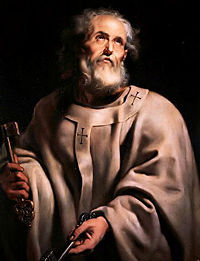Blessed John Paul II Prayed Here
Silence invites visitors to pray at St. Hedwig’s Cathedral.
In the German capital of Berlin, there is a cathedral that gave me rest during my travels last summer. This Catholic house of worship connected me in a way to our larger Catholic Church and aroused my interest in the history, advances and setbacks that our Church experiences in other lands.
In a world-class city where English is widely spoken and there are must-see museums such as the Alte Nationalgalerie, palaces like Frederick the Great’s Sanssouci, and plenty of other things to see and do — visit the Berlin Wall, take a cruise on the River Spree, shop at the largest department store on the continent, and enjoy a pastry at any of the many old coffee houses — a visit would not be complete without stopping for prayer at St. Hedwig Cathedral (Hedwigs-kathedrale.de/en/).
Located at the Bebelplatz, near Humboldt University, in downtown Berlin, it is a good place to stop amid sightseeing for some time of prayer or Mass.
St. Hedwig’s Cathedral reflects martyrdom, beauty, history and a reminder of Matthew 18:16: "And so I say to you: You are Peter, and, upon this rock, I will build my church, and the gates of the netherworld shall not prevail against it." St. Hedwig’s has weathered many storms, but it has survived.
After defeating the Silesians in the Second Silesian War (1744-1745), Frederick the Great of Prussia wanted to bind the Catholic nobility of Silesia to the Prussian crown. As a sign of tolerance and to accommodate the many Catholic Silesians who came to the Prussian capitol of Berlin, Frederick ordered a Catholic church to be built, modeled after the Pantheon in Rome.
When the foundation stones were laid for St. Hedwig’s in 1747, it marked the building of the first Catholic church in post-Reformation Prussia. Prior to this, Catholic Mass in Berlin was only performed in the chapels of the Catholic embassies.
On Nov. 1, 1773, the church was officially opened. It was named after St. Hedwig, patroness of Silesia and Berlin. St. Hedwig (1174-1273) was actually a duchess of the Silesian lands and was known for her piety and support of various monasteries. She was good to the poor and used her vast wealth to support the church in many ways. Her feast day is Oct. 16.
In 1930, the church became a cathedral to accommodate the newly formed Diocese of Berlin.
St. Hedwig’s has been through a history of periodic persecution, indifference and outright destruction. St. Hedwig’s was "tolerated" after the Reformation, bombed and almost completely destroyed during a World War II air raid and, now, serving a city that had been divided by the Berlin Wall, stands as a prayerful monument of resilience in a world that has not always appreciated it.
Although the church was consecrated on All Saints’ Day in 1773, it wasn’t considered complete until 1887 due to lack of funds.
The church has many treasures. Among them is a silver-gilded reliquary of St. Hedwig holding a statue of the Madonna and a model of a church presented at the consecration by the Holy Cross Collegiate Church in Breslau. It is the work of Andreas Heidecker and is dated to 1513. Another treasure of interest is a seated statue of St. Peter, presented to the church in 1980 by Pope John Paul II on the occasion of the 50th anniversary of the founding of the diocese. The statue, which is carved and painted, shows Peter with the keys and bishop’s mitre holding his right hand up in blessing. It is believed that this piece, which now holds a prominent place in a niche near the high altar in the upper church, dates from around 1340 and comes from Siena.
During World War II, on the night of March 1 and into the morning of March 2 in 1943, St. Hedwig’s was nearly destroyed. What was demolished in one night took 11 years to rebuild. During the reconstruction of 1952-1963, it was decided that a lower church or undercroft would replace the crypt. The undercroft today is most interesting. It consists of eight rooms. Each one of the rooms is a little chapel. One is the chapel of St. Otto (1062-1139), the second patron of the diocese. Another chapel is a memorial chapel commemorating deceased bishops who held office in Berlin; there is a baptismal chapel; the St. Hedwig chapel contains a carved figure of the patron saint dating to approximately 1725. There is a sacristy chapel, which is also used as a treasury. This is where, in a glass display case, the St. Hedwig reliquary is kept.
The last chapel is the burial place of cathedral provost Bernhard Lichtenberg (1875-1943). Father Lichtenberg, who was beatified by Pope John Paul II on a visit to Germany in 1996, was an outspoken defender of the Jewish people during the Nazi reign. He was arrested by the authorities and imprisoned. He requested to be sent to the concentration camps so he could minister to the inmates. Instead, he was offered freedom on the condition that he would not preach until the war was over. He refused. On his way to Dachau, he died.
This beautiful cathedral is an oasis of silence and prayer, a true retreat in which we can maintain our spiritual life while vacationing — and thank God for all he has given us.
James Carmody writes from Stratford, Connecticut
.
- Keywords:
- April 7-20, 2013
















